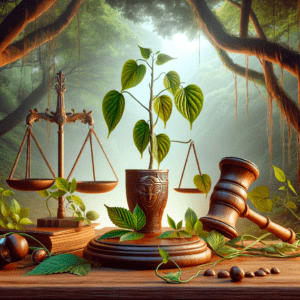Matteo Politi
Advances in scientific research in recent decades have brought unprecedented attention to ayahuasca, the sacred plant brew of the Amazon. Researchers are confirming what the Indigenous people have been affirming for centuries: ayahuasca is an exceptional medicinal concoction, with diverse properties and potential therapeutic applications.
Western society is looking to exploit this immense potential. Shamanic tourism has lived a couple of decades of boom and I recently learned of a patent application for synthetic ayahuasca that has been pending for a number of years.
According to the patent application filed in 2016 by German citizen Thomas Herkenroth (currently under examination), two or more of the bioactive molecules contained in the ayahuasca brew (harmine, harmaline, N,N-Dimethyltryptamine (DMT), mono-N-methyltryptamine, among others) can be extracted and purified from different plant sources, or even independently synthetized, and then reassembled into a specific combination, composition, mixture and pharmaceutical preparation. The result represents the so-called ‘synthetic ayahuasca’, which can have therefore a defined and desired concentration of the selected bioactive molecules. In the patent application several potential uses for synthetic ayahuasca are also suggested such as enjoyment, nutritional preparation, therapy, together with the processes for extracting and purifying the bioactive molecules.
Faced with such a scenario, an extreme feeling of boredom arises. History seems to repeat itself: notably Western arrogance of appropriating Indigenous heritage for private benefits. In 1986 a patent on the very ayahuasca vine for the benefit of American citizen Loren Miller was granted, which ten years later prompted a reaction on the part of an alliance of Amazonian Indigenous peoples. A limited patent was granted, which expired in 2003.
This time around, the overall situation seems trickier and more difficult to tackle. In order to explore the topic, I interviewed an expert in the field of patenting traditional herbal medicines.
A conversation about misappropriation and reciprocity
My background is in natural product chemistry and because of my deep interest in medicinal plants I’ve been working for a few years as a research director at the Takiwasi Center in Peru. After discussing about the patent attempt on synthetic ayahuasca with Jacques Mabit, MD, and founding president of Takiwasi, I decided to contact a colleague of mine, Alan Hesketh, with whom I’ve collaborated with before, as co-author of two papers about the implementation of the Nagoya Protocol on Access to Genetic Resources and the Fair and Equitable Sharing of Benefits, an international framework that seeks to protect both Indigenous knowledge and biodiversity.
Alan has a PhD in organic chemistry, is a European Patent Attorney, founder and CEO of Indigena Biodiversity, a company that provides research leads and commercial opportunities based on natural genetic resources. The mission of Indigena is to help biodiversity-rich countries to benefit from their local genetic resources, mainly plant species.
The exchanges that I had with Alan about how the world of patenting works quickly led to another key topic in my opinion, which is that of reciprocity.
Matteo Politi
Alan, it would be nice if you could advise us on how to uncover and better explain to the general public the overall situation related to the attempt to patent synthetic ayahuasca.
In my understanding, in general terms, in 1992 the Convention on Biological Diversity (CBD) held in Rio de Janeiro started a process to prevent certain types of exploitation of genetic resources and related traditional knowledge. After almost 30 years we are still struggling with this issue. With regard to the example of synthetic ayahuasca, traditional medicines can be easily replicated with semi-synthetic analogues, bypassing actions to share benefits. Let’s imagine explaining this to an Indigenous healer, how would we justify these actions?
Alan Hesketh
The patent application is filed only in Germany and is not yet granted. The invention is about two classes of constituents of the natural plant material, in a defined ratio to one another and purified to remove unknown or variable secondary ingredients.
It is possible to patent extracts of plants and isolated constituents. The requirements are that the product must be novel and inventive over what is already known. It follows therefore that a patent cannot prevent existing uses of a plant or its known extracts. A patent cannot stop you doing what you were doing before the patent application was filed.
Whether this patent application will be granted depends on the particular prior art, but there is no other reason why a patent of this type could not be granted. I understand that ayahuasca has spiritual significance in Peru and in other countries. But it has also been well known internationally for many years and has been investigated medically and chemically. Even if plant material had been exported for this research, the Nagoya Protocol is not relevant because it is not retrospective. Patenting derivatives of a plant that is a National Heritage does not affect the traditional use of that plant.
MP
We are aware of a previous case of a patent related to the ayahuasca vine (by Loren Miller in 1986). Although completely different to that one we are discussing here (in the previous case the plant itself was patented), the problem remains for the current synthetic ayahuasca patent. The author of the patent has used both scientific and traditional knowledge that are in the public domain, to create and protect an invention that was actually already invented first by nature (as individual chemicals), secondly by Indigenous humans (as chemical mixtures), and thirdly confirmed by scientist-humans (for the biological effects). So, is it possible to patent such a pre-existing knowledge, especially without considering any potential benefit sharing actions for Indigenous people, scientists, and even nature?
AH
Plant patents are only available in the USA. In Europe, we have plant breeders’ rights for new varieties. But the effect is the same. And in both cases, the variety must be new. That was the issue in the Loren Miller ayahuasca vine case.
Coming back to the more recent issue of so-called synthetic ayahuasca, the description is itself a bit of a misnomer, coined by the patentee. It is not really synthetic ayahuasca. That is just a handle, which leads to some confusion.
In patenting an invention, the prior knowledge provides a starting point, but an invention, by definition, must be something new. It is not possible to patent pre-existing knowledge. An invention must add something new, even if it is not always a major breakthrough. There can be small steps that may be patentable. But the idea must be both novel and inventive. If ayahuasca was not already internationally known and researched, the CBD and Nagoya Protocol would require access and benefit-sharing (ABS) agreements. But that is not the case here. One point to remember is that the CBD is not retrospective. It does not tackle the issue of genetic resources that were widely known internationally before 1992. And anything we do as scientists can always be improved by others. If I put my findings into the public domain, they are free for others to use. I don’t think we can expect benefits if someone takes that public knowledge to make their own invention.
The applicants of the German patent have indeed based their idea on existing knowledge. They have taken the known constituents of ayahuasca, isolated and purified them, by removing unwanted constituents, and then put them back together in a defined ratio. In so doing, they have produced something new. It is no longer ayahuasca. It may only be a small step, but if their product has improved properties, it may be patentable.
Now I am not saying that all attempts to patent an idea should be granted. The paper I wrote with Michael Heinrich on the Maca issue tries to take a balanced view. And, I refer there to the example of the attempt to patent the anti-fungal effect of neem oil. The patent was revoked because the antifungal activity had been known previously from traditional knowledge. So we need to put the patenting of natural products into perspective. We should not condone abuses of the patent system, but at the same time, we should not unduly hinder scientific progress.
MP
In the case of synthetic ayahuasca, the author actually refers to molecules that were originally invented by nature (as you also noted, the patent does not refer to truly synthetic molecules, but it is just a matter of purified natural products assembled in due dosage in accord with the traditional indications). Especially for this kind of patent, a benefit sharing action with, at least, the very same ‘nature’ should be actually foreseen (in form, for example, of allocating part of the benefit derived by the patent for ‘green’ actions or initiatives).
This is not just the romantic perspective of a scientist, but it is in line with the concept of reciprocity often used to describe the traditional attitude to give back if something is taken from nature.
Do you think that our Western culture will ever develop an egalitarian attitude toward nature as occur for most of animistic, traditional cultures? What is preventing such a shift?
We have a lot to learn from such kind of traditional cultures especially on matters related with environmental conservation and sustainability, so I think that our attempt for a truly Green Deal should certainly include their voices and perspectives.
AH
I realize, of course, that there is a difference between nature creating atoms and nature putting together specific molecules in a plant species. The point I was making was that the issue of inventions and patentability is not simply about nature inventing something. Whatever nature produces, it is often possible to adapt nature’s products to make something new. That new thing may be a major invention, like synthesizing a new molecule from nature’s atoms, or a more minor invention, like removing unwanted impurities from a natural plant’s ingredients. Yes, there is a big difference between those two inventions, but the principle is the same, that novel ideas, big or small, may be patentable.
Patentability is one issue, but the issue you raise is benefit sharing when we take advantage of nature’s resources. We should distinguish between the two issues. We can gain benefit from nature’s resources, whether or not we can obtain a patent. Should there be reciprocity? There is no question that, historically, that has not been the mindset in Western culture. The prevalent attitude was that plant species are growing naturally, so are free for all to take and use. That attitude has certainly changed, but we have some way to go before we see the fully egalitarian attitude you are looking for. How far can we go? And how can we do it?
The CBD and Nagoya should have been the catalyst for change. Great objectives. What went wrong? The problem was that the politicians set out the principles and left the implementation to the bureaucrats. Added to that was a mistrust between the two sides that could make it work – on the one hand Western industry and on the other hand biodiversity-rich countries. Can that mistrust be broken down? I believe it can. But only by each side understanding the other’s point of view. As Jeremy Narby related in his experience writing about being seen as a White vampire gringo, it’s all about dialogue. It was to help that dialogue that I founded Indigena Biodiversity.
I certainly agree that industry should listen to the voices and perspectives of traditional cultures. But it is a two-way street. There also needs to be an understanding of industry perspectives and the realities of commercialization.
We will get there.
Conclusion
In my understanding, there is a continuum between the so-called concept of reciprocity and Western attempts to regulate the benefit-sharing mechanism related to the use of indigenous plant material and traditional knowledge. Reciprocity is inherent to the Indigenous world. When using a natural resource, you have to make a payment back to the earth, to the plants, to the animals, or to the spirits in order to balance and compensate that action. It is a living relationship with an intelligent and conscious world. Nature is not just a biological system but a living, operational space with which human beings can establish intelligent relationships. This concept is clearly expressed in Indigenous traditions, but needs to be further integrated into Western society. Reciprocity involving money is a contribution that should not leave aside the rituality of reciprocity, a step toward a less-materialistic level of exchange and dialogue with nature.
Since the so-called “discovery” of the new world, the relationship between the Western and the Amazonian Indigenous world became a colonial and exploitative one, These dynamics persist in contemporary times, as illustrated by the patent case presented here. This is based, in fact, on the Western regulatory mechanism to protect a supposed Western invention – an invention that includes the very same indigenous name ayahuasca, and assumes to have improved on this traditional herbal medicine thanks to the molecular approach it was subject to. Reducing a complex herbal medicine into a few chemicals packaged in pill form should be recognized more like an act of cultural and scientific impoverishment rather than one of progress and innovation.
The dialogue between the Western and the Indigenous world should be reciprocal, and this would entail for the Westerners to listen in silence (at least for awhile) and learn about traditional medicines, and to provide contributions, rather than a continuous, blatantly profit-oriented appropriation. In this way we can try to rebalance and make amends for the unfair exchanges that have taken place between both worlds, enabled by the disparity of their military and socio-economic systems.
Acknowledgments
This article is part of a discussion fueled by several important contributions. I would like to thank Alan Hesketh for his openness to dialogue, Jacques Mabit for encouraging me to explore the topic, Fabio Friso for the editing, and Jeremy Narby for reading the article and providing the final inspiration.
Photo by Jill Burrow from Pexels



